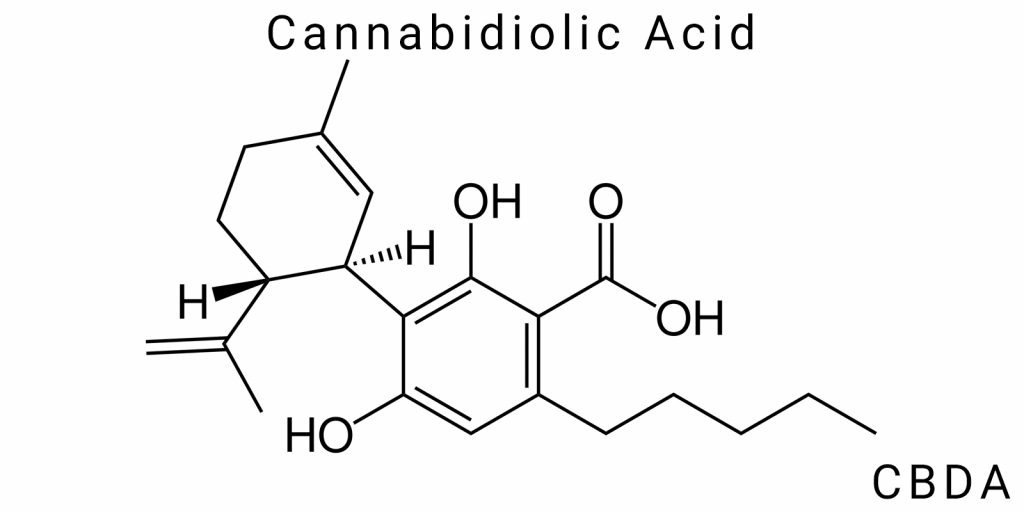Over the past few decades, natural cannabinoids have become the subject of intense scientific interest due to their unique biochemical profiles and potential therapeutic effects. Substances found in plants of the Cannabis genus, particularly cannabidiol (CBD), tetrahydrocannabinol (THC), and their precursors, are actively studied in the context of treating a wide range of pathologies: from neurological disorders to inflammatory processes and oncological diseases.
Cannabidiolic acid (CBDA), the natural carboxylated form of CBD, occupies a special place among these compounds. CBDA exhibits promising biological properties and is currently being considered as a potential pharmacological agent. Unlike CBD, which forms as a result of thermal or time-induced decarboxylation, CBDA is the primary biosynthetic compound in the living plant. As most research has historically focused on decarboxylated forms of cannabinoids, CBDA has remained underexplored for a long time.
However, recent scientific data indicate that CBDA possesses its own unique mechanism of action, distinct from CBD and other derivatives. In the context of the global search for new therapeutic strategies, the antiemetic, anti-inflammatory, and even potentially antimetastatic properties of CBDA, observed in preclinical models, deserve particular attention.
In light of the growing scientific and clinical interest, the aim of this work is to provide a systematic review of the key aspects of cannabidiolic acid: its biogenesis, methods of extraction, pharmacological profile, and the prospects for clinical application.
What is Cannabidiolic Acid (CBDA)?
Cannabidiolic acid (CBDA) is a natural organic compound from the class of phyto-cannabinoids, formed in Cannabis sativa L. plants during biosynthesis. It is the primary acidic form of cannabidiol (CBD), resulting from the enzymatic transformation of its precursor-cannabigerolic acid (CBGA)-by the specialized enzyme CBDA synthase.
Chemically, CBDA has the formula C₂₂H₃₀O₄ and is distinguished by the presence of a carboxyl group (–COOH), which defines several of its physicochemical and biological properties. The presence of this group results in higher polarity, thermal instability, and greater water solubility compared to decarboxylated forms of cannabinoids. Under heat, ultraviolet light, or prolonged storage, CBDA easily transforms into CBD through a decarboxylation process, releasing a molecule of carbon dioxide (Journal of Natural Products, 2020).
Naturally, CBDA is predominantly present in raw or minimally processed plant biomass. During thermal processing (e.g., drying or smoking), a substantial conversion of CBDA to CBD occurs, which explains the high content of the latter in final cannabis consumption products. Thus, CBDA is an intermediate biological form that primarily exists during the plant’s life cycle before harvesting and processing.
Historically, most research has focused on studying cannabidiol due to its recognized pharmacological properties, while cannabidiolic acid remained relatively underexplored. It was only in the past decade, thanks to advances in biochemical analytical methods, that CBDA began to be considered as an independent therapeutic molecule with unique properties.
Modern research demonstrates that CBDA possesses potential biological activity, including anti-inflammatory, anxiolytic, antiemetic, and antimetastatic effects. Its interaction with various molecular targets, particularly the serotonin receptors of the 5-HT₁A type, opens new avenues for the application of CBDA in medical practice.
Chemical and Pharmacological Characteristics of CBDA
Cannabidiolic acid (CBDA) is a typical representative of the class of natural cannabinoids with distinctly acidic properties. The presence of the carboxyl group causes high polarity, significantly affecting its physicochemical stability, solubility, and reactivity. The molecular weight of CBDA is 358.48 g/mol, and its crystalline form at room temperature is stable only under protection from light and heat.
One of the most characteristic features of CBDA is its high sensitivity to decarboxylation. Under heat or prolonged exposure to ultraviolet light, CBDA loses its carboxyl group (–COOH), forming CBD. This process holds practical significance, as the composition of the final cannabis product changes depending on the degree of preservation of the acidic forms.
Pharmacologically, CBDA differs from classical psychoactive cannabinoids such as Δ9-tetrahydrocannabinol (THC) because it has minimal activity on CB₁ and CB₂ receptors. Instead, CBDA demonstrates significant activity on other biological targets. In particular, CBDA acts as a potent agonist of the 5-HT₁A serotonin receptors, as confirmed in several studies. This provides a basis for considering CBDA as a promising agent for combating nausea, particularly when traditional 5-HT₃ antagonists prove ineffective.
Moreover, CBDA has the ability to inhibit the enzyme cyclooxygenase-2 (COX-2), a key factor in the development of the inflammatory response. This suggests that CBDA could be a potential natural anti-inflammatory agent with selective action, distinct from the mechanisms of non-steroidal anti-inflammatory drugs (Frontiers in Pharmacology, 2022).
Other promising research directions include studying the antiproliferative properties of CBDA in relation to certain types of malignant cells, particularly in aggressive forms of breast cancer. Experimental models have shown that CBDA can reduce the expression of enzymes associated with metastasis.
Pharmacokinetic data indicate that CBDA has higher bioavailability when administered orally compared to CBD, which is related to its greater solubility in aqueous environments. However, the instability of the acidic form requires special storage conditions and the development of protected pharmaceutical formulations.
Role of CBDA in Cannabis Plants
Cannabidiolic acid (CBDA) plays an important biological role in the physiology and defense of Cannabis sativa L. plants. It is not merely an intermediate product of the biosynthesis of other cannabinoids, but actively participates in the mechanisms of plant adaptation and survival in the natural environment.
One of CBDA’s main functions is its involvement in protecting the plant from pathogenic microorganisms. Cannabinoids in their acidic form, including CBDA, demonstrate natural antimicrobial properties. CBDA can inhibit the growth of certain bacteria and fungi, thereby reducing the risk of infectious diseases in the plant.
In addition to antimicrobial activity, CBDA acts as a secondary metabolite involved in allelopathic interactions. The plant produces this compound to create an unfavorable environment for competing species growing nearby. This defense is provided through the secretion of cannabinoids into the surrounding environment or localized action within the plant’s tissues.
CBDA also contributes to protecting the plant from pests due to its bitter taste and potential toxicity to certain insect species. The high concentration of acidic cannabinoids in trichomes-specialized glandular structures on the plant’s surface-serves as a barrier against mechanical damage and biotic threats.
From an ecological perspective, the synthesis of CBDA is an energy-intensive process for the plant, indicating its high biological significance. Under abiotic stress conditions such as drought or excessive ultraviolet radiation, the concentration of CBDA in plant tissues may change, suggesting its potential involvement in stress resilience mechanisms.
Biogenesis: What is CBDA Made From?
Cannabidiolic acid (CBDA) is the result of a specific biosynthetic pathway that occurs exclusively in the trichome cells of the Cannabis sativa L. plant. The process of CBDA synthesis begins with simple organic molecules and unfolds through a series of enzymatic reactions, which ensure the formation of a complex cannabinoid structure.
The biosynthetic pathway of CBDA starts with the formation of two precursors-geranylgeranyl pyrophosphate (GPP) and olivetolic acid (OA). Geranylgeranyl pyrophosphate is a key isoprenoid substrate that is formed within the mevalonate pathway, characteristic of terpene compounds. Olivetolic acid, in turn, is a product of the polyketide synthesis, similar to the processes involved in fatty acid formation.
In the presence of the specific enzyme cannabigerol synthase (CBGAS), geranylgeranyl pyrophosphate and olivetolic acid interact to form cannabigerolic acid (CBGA)-a central intermediate product in the biosynthesis of all major cannabinoids. The process then moves into a specific phase-under the action of cannabidiol synthase (CBDAS), the enzyme protein, CBGA is converted into cannabidiolic acid (CBDA). A distinctive feature of this reaction is the high specificity of the enzyme: CBDAS catalyzes an oxidation-reduction reaction, which results in the formation of exclusively CBDA from CBGA without significant by-product formation.
Interestingly, the activity of the CBDAS enzyme can vary depending on the genetic traits of the plant and cultivation conditions. Cannabis strains bred for high CBD content typically demonstrate high expression of the CBDAS gene, ensuring that CBDA dominates in the cannabinoid profile.
From an ecological standpoint, the biogenesis of CBDA is an adaptive process: the accumulation of cannabidiolic acid helps the plant more effectively withstand environmental stress factors, including pathogens and abiotic stresses.
Physiology of Synthesis: How CBDA Forms in the Plant Through the Action of the CBDA Synthase Enzyme
The synthesis of cannabidiolic acid (CBDA) in Cannabis plants is the result of an intricate biochemical process that occurs under the influence of a specific enzyme-CBDA synthase. This enzyme is responsible for converting cannabigerolic acid (CBGA) into cannabidiolic acid (CBDA), an important step in the formation of cannabinoids.
CBDA synthase has a high specificity for its substrates. It can selectively convert CBGA into CBDA by catalyzing a reaction that involves the removal of the carboxyl group from the CBGA molecule. The product of this reaction, CBDA, is an acid that serves as a precursor to cannabidiol (CBD); however, in its initial form, it has properties that differ from CBD, including greater activity in the context of potential pharmacological effects.
This synthesis process occurs primarily in the trichomes-specialized hairs on the surface of the plant, which contain a high concentration of cannabinoid compounds. The CBDA synthase enzyme, localized within these cells, acts as the main catalyst facilitating the formation of CBDA from the preceding compound (CBGA).
Despite the simplicity of the reaction, the physiology of CBDA synthesis is complex and depends on various factors such as light conditions, humidity, and the plant’s genetic characteristics. For example, the expression of the CBDA synthase gene may vary depending on the type of cannabis and growing conditions, which, in turn, influences the level of CBDA accumulation in the plant’s tissues.
This synthesis mechanism is not only important for the formation of cannabidiolic acid but also for the overall chemical balance of cannabis, as CBDA is a precursor to other important cannabinoids such as CBD. Understanding this process is crucial for the development of selection methods and the refinement of pharmaceutical preparations based on cannabinoids.
Sources: Primarily Industrial and Medicinal Strains of Cannabis sativa L.
The primary sources of cannabidiolic acid (CBDA) are specialized strains of cannabis cultivated for medicinal and industrial purposes. Cannabis sativa is typically divided into two main groups: strains rich in tetrahydrocannabinol (THC) and those with high concentrations of cannabidiol (CBD). Cannabis strains bred for high CBD production and its acidic form (CBDA) are used in medicinal and pharmaceutical applications, as this cannabinoid exhibits a range of therapeutic properties.
In industrial cannabis cultivation, particularly in countries where the cultivation of non-psychoactive cannabis for technical raw materials is allowed, strains with low THC content and high CBD levels are used. These strains are often referred to as “industrial hemp” and have the highest ratio of CBD to THC. Industrial cannabis strains grown for fiber, seed, and oil production also contain significant concentrations of CBDA, as this is the main cannabinoid at the early stages of the plant’s development.
Medicinal cannabis strains, in contrast, are selectively bred to maximize the content of CBDA and CBD while minimizing THC content, making them suitable for patients seeking cannabis effects without the psychoactive impact. High levels of CBDA in such strains facilitate more efficient absorption of cannabidiol in the human body when processed through thermal or other physicochemical methods.
The most promising cannabis strains for medical use are those with high levels of cannabidiolic acid combined with other cannabinoids and terpenes that have a synergistic effect. Strains bred for these purposes are actively researched in clinical trials, which demonstrate the effectiveness of CBDA in reducing inflammation, pain, anxiety, and other symptoms characteristic of a wide range of medical conditions.
Thus, the primary sources of CBDA are medicinal and industrial strains of Cannabis sativa L., which, thanks to selective breeding processes, have high levels of cannabidiolic acid. These strains, due to their genetic specificity, ensure high productivity and purity of cannabinoids, which is essential for their further use in medical and pharmaceutical applications.
Methods of Obtaining CBDA
The extraction of cannabidiolic acid (CBDA) is a crucial step in the creation of cannabinoid-based products, especially for medical and pharmaceutical purposes. One of the most common methods is extraction from plant material, which involves the use of various solvents such as ethanol or hexane. These methods allow effective isolation of cannabinoids, including CBDA, from plant material, although solvent residues may remain during the extraction process, which require further purification. The application of supercritical CO₂ extraction, where carbon dioxide is used in a supercritical state, enables the extraction of cannabinoids without the use of harmful solvents, preserving the high quality of the product. After extraction, chromatography methods are typically used for purifying CBDA, including high-performance liquid chromatography (HPLC), which yields highly purified CBDA, and thin-layer chromatography (TLC), which is used for preliminary composition evaluation of extracts. Recently, biotechnological methods have been developing, where genetically modified microorganisms are used for synthesizing CBDA, allowing the production of stable and controlled amounts of cannabidiolic acid, independent of seasonal fluctuations in plant yield. However, these methods are still in the research stage and require further optimization to achieve commercial efficiency.
Extraction: Supercritical CO₂ Extraction, Ultrasound Extraction, Cold Selection
One of the most effective ways to obtain CBDA is through the use of advanced extraction methods, which allow the extraction of cannabidiolic acid with high purity while minimizing the degradation of its molecule. Among such methods, the following stand out:
- Supercritical CO₂ Extraction is a technology that uses CO₂ in its supercritical state, where it exhibits both liquid and gas properties. This extraction method allows for the production of pure cannabinoid extracts without the use of harmful solvents, making it ideal for medical use. A significant advantage is that CO₂ does not interact with cannabinoids at the molecular level, preventing the degradation of CBDA.
- Ultrasound Extraction uses high-frequency sound waves to create microscopic bubbles in a liquid, causing mechanical disruption of plant cells and facilitating the release of cannabinoids into the solvent. This method is more energy-efficient compared to traditional extraction techniques and also reduces extraction time while maintaining a high purity of the product.
- Cold Selection is a method used at low temperatures to preserve the natural properties of CBDA. During cold extraction, various organic solvents, such as ethanol or hexane, are used at temperatures not exceeding 10-15°C. This approach minimizes the conversion of CBDA into CBD, which is critical for preserving the active form of the acid.
Stabilization: Features of Preventing Decarboxylation (Conversion of CBDA to CBD)
The stabilization of CBDA is an important stage in its production process, as cannabidiolic acid is prone to decarboxylation – conversion into CBD when exposed to heat. To prevent this process, several approaches have been developed:
- Lowering the Temperature during Extraction and Storage is one of the main methods for stabilizing CBDA. High temperatures activate the decarboxylation process, reducing the efficacy of CBDA. Using low temperatures helps preserve the cannabidiolic acid in its original form and minimize the loss of active components.
- Rapid Cooling of the Extract after Extraction also promotes the stability of CBDA. After extraction, the extract is cooled to temperatures below 4°C to prevent the conversion of CBDA into CBD.
- Encapsulation and Microencapsulation can also be used to stabilize CBDA. In this case, cannabidiolic acid can be incorporated into special capsules that protect it from external factors such as high temperature or oxygen, thereby preventing decarboxylation.
Scientific Approaches to Preserving the Active Form
Modern scientific research is actively working on improving methods for preserving the active form of CBDA, as this compound holds therapeutic potential. Several approaches are currently being studied, including:
- Optimization of Storage Conditions: Storing CBDA at low temperatures or in special containers that exclude oxygen and light helps preserve the active form of cannabidiolic acid for long periods. Vacuum packaging or inert gases are used to prevent oxidation and conversion of CBDA into CBD.
- Use of Antioxidants: Adding antioxidants to cannabinoid formulations is also an effective way to preserve CBDA stability. Antioxidants prevent oxidation and help maintain the chemical stability of active components.
- Genetic Approaches to Plant Breeding: The development of new cannabis strains genetically resistant to decarboxylation is a promising direction. Breeders are working on creating strains with a high CBDA content throughout all growth stages, ensuring the stability of this compound even during processing and storage.
Biological Activity and Potential of CBDA
Cannabidiolic acid (CBDA) is attracting scientific attention due to its therapeutic properties, which may have significant potential in medicine and pharmaceuticals. It demonstrates pronounced anti-inflammatory activity by inhibiting enzymes that promote the synthesis of prostaglandins-mediators of inflammation. This could be useful in treating chronic inflammatory diseases such as arthritis. Additionally, CBDA possesses antioxidant properties, which help neutralize free radicals, reducing the risk of diseases associated with oxidative stress, including neurodegenerative diseases and cardiovascular disorders. Specifically, its ability to lower blood pressure indicates its potential use in the treatment of hypertension and in the prevention of atherosclerosis. Some studies also point to CBDA’s anticancer potential, especially in the context of breast cancer, though these results require further clinical validation.
The interaction of CBDA with cannabinoid receptors is less pronounced compared to CBD and THC; however, it may influence their activity through other biological mechanisms. This aspect opens up new opportunities for using CBDA in medical practice as a potential regulator of the endocannabinoid system. Given the diverse properties of cannabidiolic acid, its prospects in the medical field are promising, especially for the treatment of inflammatory and cardiovascular diseases, as well as cancer. However, further clinical research is needed to confirm these possibilities.
Anti-inflammatory, Anti-emetic, and Anti-tumor Properties
CBDA exhibits a range of therapeutic effects, contributing to its use in medical practice, particularly due to its anti-inflammatory, anti-emetic, and anti-tumor properties.
Anti-inflammatory Properties
Studies show that CBDA has pronounced anti-inflammatory properties, making it useful for treating chronic inflammatory diseases. This occurs due to CBDA’s ability to inhibit certain enzymes, particularly cyclooxygenase (COX), which plays a role in the production of prostaglandins-molecules that promote inflammation. Reducing the level of prostaglandins leads to a decrease in the inflammatory process, holding significant potential for treating conditions like arthritis and other inflammatory disorders.
Anti-emetic Properties
One of the important areas of CBDA research is its anti-emetic effect. This means CBDA could be useful in combating nausea and vomiting, which often occur during chemotherapy, digestive system diseases, or post-surgery. Studies have shown that CBDA can reduce the activity of receptors responsible for inducing nausea and vomiting, thus alleviating these symptoms in patients. This opens up possibilities for using CBDA as an adjunct in chemotherapy therapy and for individuals suffering from intense nausea.
Anti-tumor Properties
CBDA also demonstrates potential as an anti-tumor agent. Studies show that cannabidiolic acid can reduce the growth of cancer cells in various types of tumors, particularly in the case of breast cancer. Its mechanism of action involves inhibiting processes that promote cell division and metastasis, as well as activating apoptosis (the natural death of cells) in tumor cells. However, more clinical research is needed to confirm this potential and determine the most effective methods of using CBDA in oncology.
Review of Key Animal and Cell Culture Studies
Research on animals and in cell cultures plays a crucial role in understanding the biological activity of CBDA. These studies help evaluate the potential of this compound before it can be used in clinical practice, providing more detailed insights into its mechanisms of action and possible therapeutic effects.
Animal Studies
One of the significant areas of CBDA research on animals concerns its anti-inflammatory properties. Studies conducted on laboratory mice showed that CBDA administration reduces inflammation levels by decreasing the amount of prostaglandins in tissues. This confirmed its potential as a therapeutic agent for treating inflammatory diseases such as arthritis.
Another study conducted on rats demonstrated CBDA’s effectiveness in reducing symptoms associated with nausea and vomiting caused by chemotherapy. This supports the claims of CBDA’s anti-emetic properties and its potential for use in treating patients undergoing chemotherapy.
Cell Cultures
In cell cultures, CBDA has shown promising results in terms of its anti-tumor properties. Research on breast cancer cells showed that CBDA inhibits the growth of cancer cells, reducing their ability to metastasize. This finding highlights CBDA’s potential as an anti-cancer compound, although further clinical studies are needed to confirm these effects in humans.
Additionally, studies on cells undergoing oxidative stress demonstrated that CBDA could reduce free radical levels, indicating its antioxidant properties. This is significant for the treatment of diseases related to oxidative stress, such as neurodegenerative diseases.
Comparison of CBDA’s Action with Other Cannabinoids
CBDA, as the main acidic precursor to cannabidiol (CBD), shares some similarities and differences in its mechanisms of action compared to other cannabinoids, such as CBD and THC (tetrahydrocannabinol). Understanding these differences is crucial for determining the therapeutic potential of each compound in the context of various diseases.
Comparison with Cannabidiol (CBD)
CBDA and CBD share a common origin and both exhibit significant biological activity; however, there are important differences between them. CBDA is the acidic form of CBD, and unlike CBD, it does not interact with cannabinoid receptors CB1 and CB2 in the same way. CBD is a more stable compound that actively interacts with the receptors of the endocannabinoid system and demonstrates numerous therapeutic effects, including reducing anxiety, antidepressant, and anti-inflammatory properties. In contrast, CBDA does not have as pronounced an ability to bind to these receptors, which may affect its therapeutic activity.
However, research indicates that CBDA, with its pronounced ability to inhibit enzymes responsible for prostaglandin synthesis (COX-1 and COX-2), demonstrates powerful anti-inflammatory properties that CBD lacks. Given this, CBDA may be beneficial in treating inflammatory diseases, such as arthritis, where the inflammatory process is the primary mechanism of symptom development.
Comparison with Tetrahydrocannabinol (THC)
Tetrahydrocannabinol (THC), the main psychoactive cannabinoid, also differs from CBDA in terms of its mechanism of action. THC interacts with cannabinoid receptors CB1 and CB2, which results in psychoactive effects, including euphoria, changes in perception, and behavior. While CBDA does not produce these effects, it may influence certain receptors via other biological pathways.
Other studies show that CBDA may interact with receptors that are not part of the classical cannabinoid system, such as serotonin receptors, and this ability could explain its anti-emetic properties (reducing nausea and vomiting). Unlike THC, which can induce unwanted nausea in some patients, CBDA may have a therapeutic effect in combating such symptoms.
Overall Comparison
Thus, CBDA has a more specific mechanism of action, which does not include pronounced binding to cannabinoid receptors CB1 and CB2, unlike CBD and THC. However, its ability to inhibit enzymes involved in inflammatory processes and its anti-emetic properties make it a valuable component of potential therapy for patients with chronic inflammatory diseases and those undergoing chemotherapy.
In general, although CBDA does not have the same psychoactive effects as THC, it may exhibit unique therapeutic properties that could complement or even surpass the effects of other cannabinoids in certain clinical situations.
Current Applications and Potential Research Directions
CBDA, as one of the most promising cannabis compounds, is currently being applied in a variety of medical fields. Given its biological activity, it has the potential to significantly improve the quality of life for patients with various diseases and holds great promise for further scientific research. The current applications of CBDA include anti-inflammatory therapy, antiemetic effects, and support for the cardiovascular system.
One of the primary areas of its use is the treatment of chronic inflammatory diseases such as osteoarthritis and rheumatoid arthritis. Due to its ability to reduce prostaglandin levels in tissues, CBDA can significantly alleviate pain symptoms and inflammation. Furthermore, its antiemetic properties make CBDA useful for patients undergoing chemotherapy, reducing symptoms of nausea and vomiting.
Another promising area is the research into the potential use of CBDA in neurodegenerative diseases such as Alzheimer’s and Parkinson’s diseases. Due to its antioxidant properties, it may reduce oxidative stress, which plays a key role in the development of these diseases. Additionally, CBDA has potential as a supportive treatment for cardiovascular diseases, particularly hypertension and atherosclerosis, due to its antioxidant and anti-inflammatory effects.
However, despite these prospects, there are numerous potential avenues for further research. One such direction is studying the antitumor properties of CBDA, specifically its ability to inhibit cancer cell growth. Studies on cell cultures have shown its activity in reducing metastasis and tumor growth, which requires further confirmation through clinical trials.
Another important area is investigating the interaction of CBDA with other cannabinoids such as CBD and THC. The combined use of these compounds may lead to the development of new therapeutic approaches in which the combined effects of cannabinoids are more effective for treating a wide range of diseases. Exploring these mechanisms will help understand how CBDA can complement the action of other cannabinoids.
Equally important is the development of new methods for stabilizing CBDA to maintain its therapeutic efficacy over an extended storage period. Since CBDA easily decarboxylates into CBD during processing or storage, the development of technologies that prevent this process could significantly enhance its potential for medical use.
Role in Current Clinical Research
Although CBDA is still in the early stages of research in clinical medicine, it is already demonstrating its potential significance in treating a range of diseases due to its biological properties. In current clinical research, the primary focus is on determining the safety of using CBDA, its pharmacokinetic characteristics, and its effectiveness compared to other cannabinoids.
Potential in Anti-inflammatory Therapy
One of the main directions of clinical research is studying the effectiveness of CBDA in treating inflammatory diseases. Specifically, clinical trials are assessing its properties as a means to reduce inflammation, particularly in chronic diseases such as arthritis or ulcerative colitis. Preliminary studies suggest that CBDA may exhibit a stronger anti-inflammatory effect compared to CBD, making it a promising option for treating these conditions.
Antiemetic Properties
Research on CBDA is also focused on its ability to reduce nausea and vomiting, particularly in patients undergoing chemotherapy. In this context, CBDA continues to attract attention in clinical trials, where its ability to reduce side effects associated with cancer treatment is being explored. Initial clinical results provide positive data regarding its effectiveness as an antiemetic therapy.
Studying Antitumor Activity
In recent years, several clinical studies have focused on investigating the potential of CBDA in oncology. It is known that this compound exhibits inhibitory properties against various tumor cells, and clinical trials are currently being conducted to assess its effectiveness in patients with different forms of cancer. It is important to understand how CBDA may work in combination with other anticancer agents, which could significantly enhance the effectiveness of existing treatment methods.
Safety and Pharmacokinetics
The safety of CBDA is a crucial aspect of current clinical research. Preliminary studies indicate that CBDA has low toxicity, but further clinical trials are needed to determine the exact doses and duration of use. Pharmacokinetic studies also help provide a clearer picture of how CBDA is metabolized in the body, how long it remains active, and whether there are effective methods for stabilizing it during storage and administration.
Interdisciplinary Research and Future Directions
Given the multifunctionality of CBDA, interdisciplinary research in the fields of pharmaceuticals, biochemistry, and medicine becomes an essential tool for a deeper understanding of its mechanisms of action. Clinical studies are also focusing on exploring the combined use of CBDA with other cannabinoids, as well as its potential to serve as a basis for new combination therapies that may have more advantages in treating complex diseases.
Opportunities for Using CBDA in Pain Therapy, Anxiety Disorders, and Oncology
CBDA is gaining increasing popularity as a potential therapeutic agent due to its multifunctional properties. This opens up new opportunities for treating conditions such as chronic pain, anxiety disorders, and cancer, where traditional treatments often have limited effectiveness or significant side effects.
Pain Therapy
CBDA exhibits strong anti-inflammatory properties, making it a promising agent for pain reduction, particularly in conditions associated with chronic inflammation, such as arthritis, osteoarthritis, and other inflammatory disorders. By reducing prostaglandin levels, which play a key role in pain development, CBDA may help not only reduce inflammation but also alleviate discomfort and pain. Clinical studies indicate the potential of CBDA for pain relief when other anti-inflammatory agents are less effective or have side effects.
Anxiety Disorders
CBDA also holds potential in treating anxiety disorders, especially in cases of stress or generalized anxiety. Cannabinoids are known to interact with serotonin receptors, which are crucial for emotional regulation. Some evidence suggests that CBDA may be less pronounced than THC or CBD in its effects, but it still has the ability to influence anxiety levels through its interaction with the nervous system. This makes it potentially useful for patients suffering from anxiety disorders or panic attacks, where traditional medications may cause dependence or side effects.
Oncology
In oncology, CBDA attracts attention due to its antitumor properties, which have been demonstrated in cell culture studies. Preliminary data suggest that CBDA can reduce the growth and metastasis of cancer cells, particularly in breast cancer, and improve the overall condition of patients. Not only does it inhibit tumor growth, but it also reduces chemotherapy side effects such as nausea and vomiting. At this stage, further clinical trials are needed to determine its effectiveness and safety in treating cancer, but it is already evident that CBDA holds great potential in developing new approaches to cancer treatment.
Overall, the potential uses of CBDA in pain therapy, anxiety disorders, and oncology open new horizons for treating complex and serious diseases where traditional treatment methods may be insufficiently effective. Further research will help clarify all the benefits and possible limitations of its use in clinical practice.
Stability Issues and Legal Aspects
One of the major challenges hindering the widespread implementation of CBDA in medical practice is the stability of this compound, as well as legal barriers related to the specific regulation of cannabis and its components.
CBDA faces certain challenges regarding stability, primarily due to its tendency to decarboxylate. During storage or processing, CBDA can transform into CBD (cannabidiol), which reduces its therapeutic properties. This decarboxylation can occur even at low temperatures, making it difficult for pharmaceutical companies to store CBDA properly. To address this issue, stabilization methods need to be developed to prevent decarboxylation and maintain the biological activity of CBDA over time. The use of advanced technologies such as temperature and humidity-controlled packaging, as well as special preservatives, may help resolve this problem.
From a legal standpoint, the use of CBDA faces several barriers due to the complexity of cannabis regulation. In many countries, cannabis and its derivatives, including CBDA, are subject to strict regulations regarding production, distribution, and use. This is because cannabis is a plant containing psychoactive components such as THC (tetrahydrocannabinol), even though CBDA itself is non-psychoactive. However, the legal uncertainty surrounding the status of cannabis means that the regulation of cannabinoids may vary across countries.
In some countries where cannabis is partially legalized for medical use, strict rules define the amounts and conditions for the use of cannabinoids, including CBDA. This creates legal difficulties for pharmaceutical companies seeking to develop and market new CBDA-based medications.
Another issue is the lack of clear legal standards for quality and manufacturing processes for cannabinoids. In many countries, there are no specific requirements for certifying products containing CBDA, which complicates their legalization and subsequent commercialization.
Given the growing interest in medical cannabinoids and the positive results in clinical studies, there is a possibility of gradual relaxation of legal restrictions on the use of CBDA. Specifically, some countries are already experiencing processes of cannabis legislation liberalization, which opens up new opportunities for research and the use of this compound in medical practice. At the same time, new legal norms may be developed to ensure the safety and efficacy of CBDA-based products, as well as their compliance with high-quality standards.
Conclusion
In summary, several important conclusions can be drawn regarding cannabidiolic acid (CBDA), its properties, methods of extraction, and potential for medical applications.
CBDA has garnered significant interest due to its therapeutic properties, particularly in the context of anti-inflammatory, antiemetic, and antitumor activities. This makes it a promising candidate for the treatment of conditions such as chronic pain, anxiety disorders, and cancer. Since CBDA is non-psychoactive, it offers a safe alternative for medical use, while still maintaining high efficacy in addressing various health issues.
Modern extraction methods such as supercritical CO₂ extraction and ultrasonic extraction ensure high-quality CBDA products; however, the stability of this compound remains a challenge. CBDA is prone to decarboxylation into CBD, which can diminish its therapeutic effects. Therefore, the development of new stabilization technologies is crucial to preserving the active form of CBDA and maintaining its effectiveness over extended periods of storage.
Legal aspects also pose challenges for the widespread use of CBDA, as cannabis and its derivatives are subject to strict regulatory frameworks in many countries. Although CBDA does not have psychoactive effects, there is legal uncertainty about its status, which limits opportunities for commercialization and medical use. However, given the growing interest in cannabinoids and positive research outcomes, gradual legalization and regulatory relaxation can be expected, opening up new opportunities for CBDA research and application.
The prospects for using CBDA in pain therapy, anxiety disorders, and oncology are promising. Further research is needed to confirm its clinical efficacy and safety. With its significant therapeutic potential, CBDA’s integration into medical practice could represent an important step forward in the development of new treatment methods. Overall, while challenges related to stability and legal aspects remain, CBDA’s potential for medical applications is highly promising, and it may play an important role in future treatments for various diseases.
Sources:
- National Institutes of Health (NIH) – PubMed
Open access to peer-reviewed studies and scientific articles on cannabinoids and their health impacts.
https://pubmed.ncbi.nlm.nih.gov - PubMed Central (PMC)
An open archive for scientific articles containing numerous studies on cannabinoids and their medical applications.
https://www.ncbi.nlm.nih.gov/pmc - Journal of Clinical Investigation (JCI)
A renowned medical journal that publishes high-quality scientific articles, including studies on cannabinoids.
https://www.jci.org - ScienceDirect – Journal of Ethnopharmacology
A platform featuring articles and research that analyze cannabinoids, including CBDA, from the perspective of ethnopharmacology.
https://www.sciencedirect.com/journal/journal-of-ethnopharmacology






